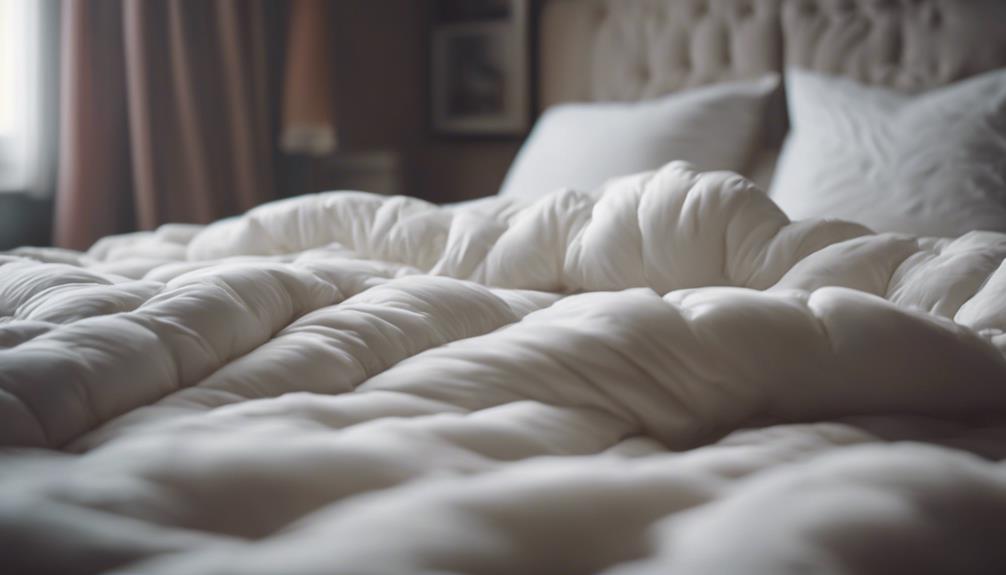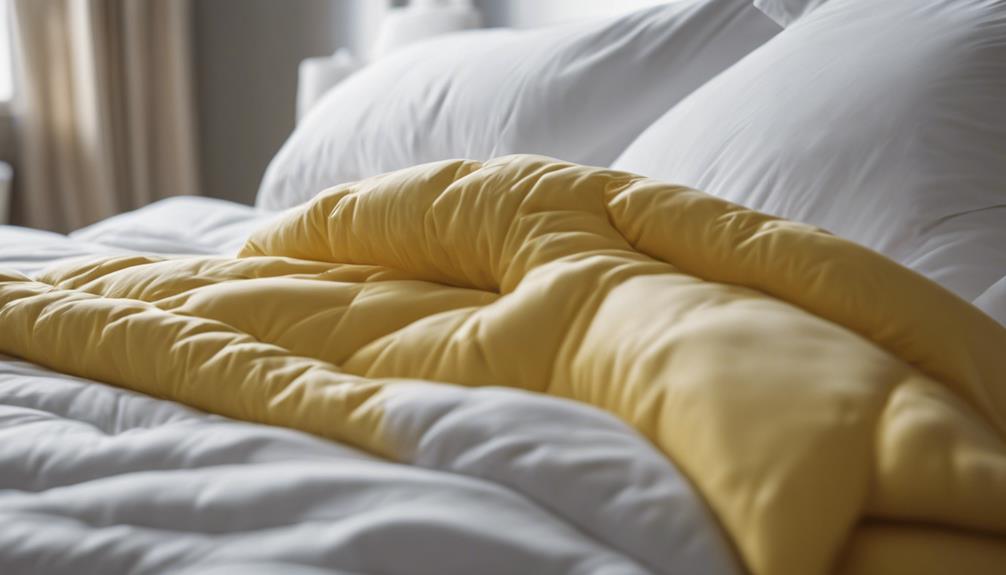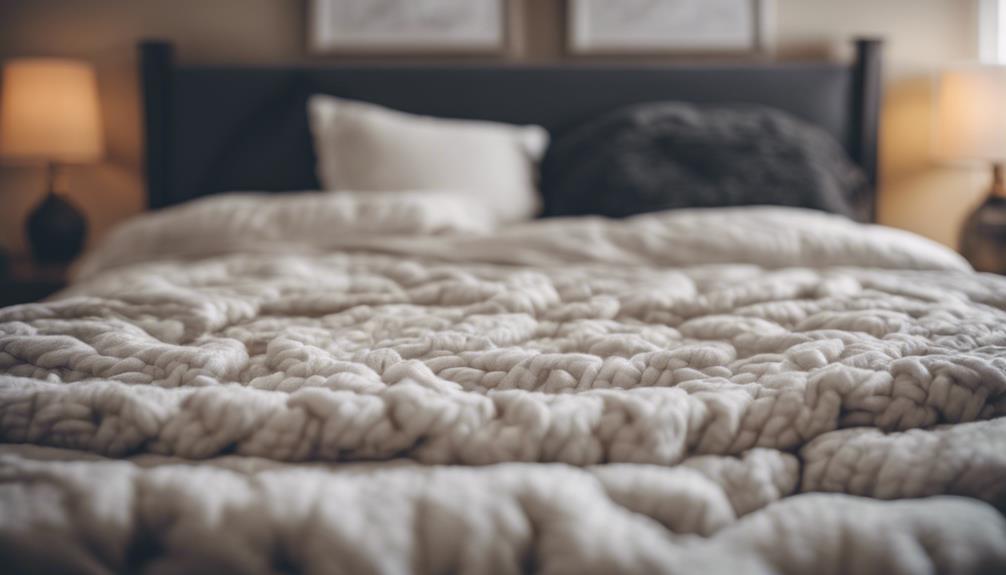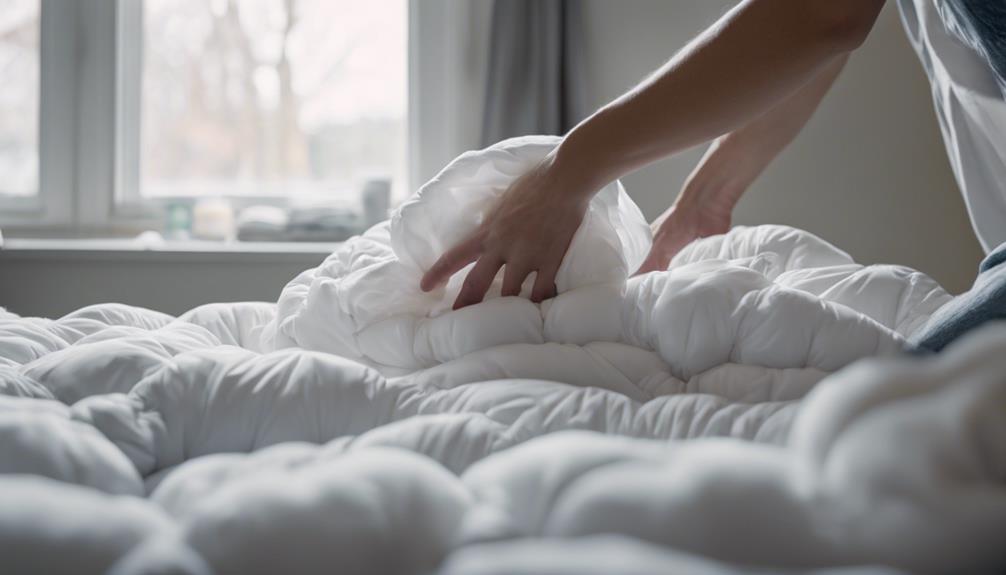When waiting for a down comforter to fluff up, it usually takes a few hours if left on the bed. To speed up the process, try daily shaking and airing. These activities can help restore the loftiness of the comforter. Patience is key, as some comforters may continue to gain loft for up to two weeks. If your comforter still doesn’t feel fluffy, replacement might be necessary. Proper care and maintenance are also important for quick fluffing. Keep up the routine for best results and loftiness. Additional insights await for enhancing your down comforter’s fluffiness.
Key Takeaways
- Daily shaking and airing aid in loftiness restoration.
- New comforters may take hours to fully fluff up.
- Continued loft gain possible for up to two weeks.
- Replacement consideration if persistent flatness persists.
- Proper care accelerates the down comforter fluffing process.
Factors Affecting Fluffing Time
Factors affecting the time it takes for a down comforter to fluff up can include the quality of the down fill, the thickness of the comforter shell, and the frequency of shaking and airing.
When dealing with a new down comforter, it's important to allow time for the down to settle and expand properly. One way to speed up this process is by using a wool dryer on a no-heat or air fluff setting. Placing the comforter in the dryer with a few wool dryer balls can help fluff up the down clusters. However, it's vital to check the manufacturer's instructions first to make sure this method is safe for your specific comforter.
Additionally, regularly shaking and airing out the comforter can also aid in enhancing its loftiness. By incorporating these practices, you can help your new down comforter reach its full fluff potential in a shorter amount of time.
Sunlight Vs. Dryer Method
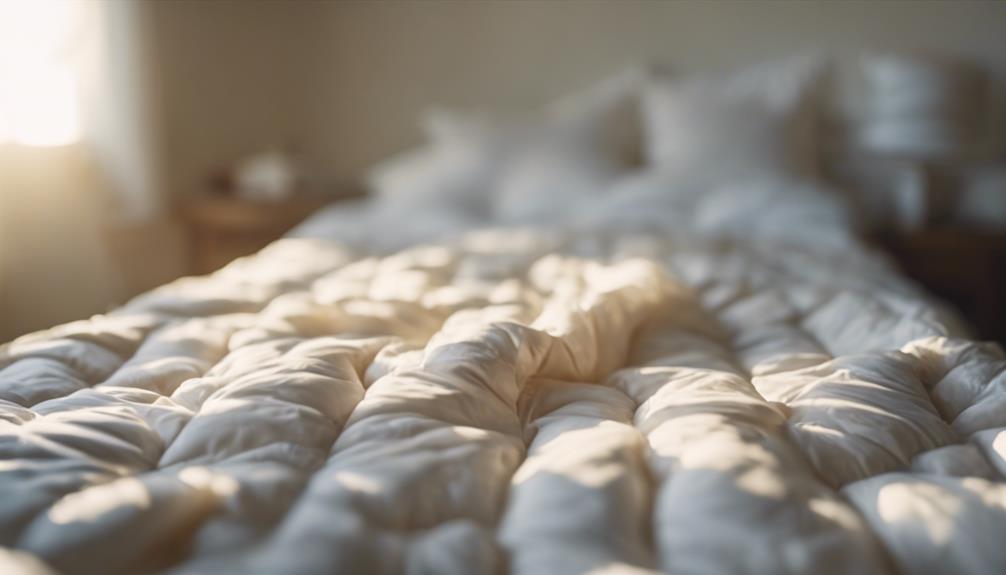
To enhance the fluffiness of a down comforter, one can opt for either the sunlight method or the dryer method with tennis balls. The sunlight method involves hanging the comforter outside for a day to invigorate it and help fluff up the down filling. Exposure to sunlight helps eliminate odors, bacteria, and can improve the loftiness of the comforter. Sunlight is effective for revitalizing comforters and pillows, recommended to leave them outside overnight for best results.
On the other hand, the dryer method with tennis balls includes washing the comforter and drying it with clean tennis balls to prevent clumping and fluff up the comforter. Using tennis balls in the dryer helps maintain the loftiness of the comforter by evenly distributing the down filling during the drying process. Both methods are effective in their ways, with the choice depending on personal preference and convenience.
Impact of Temperature Variations
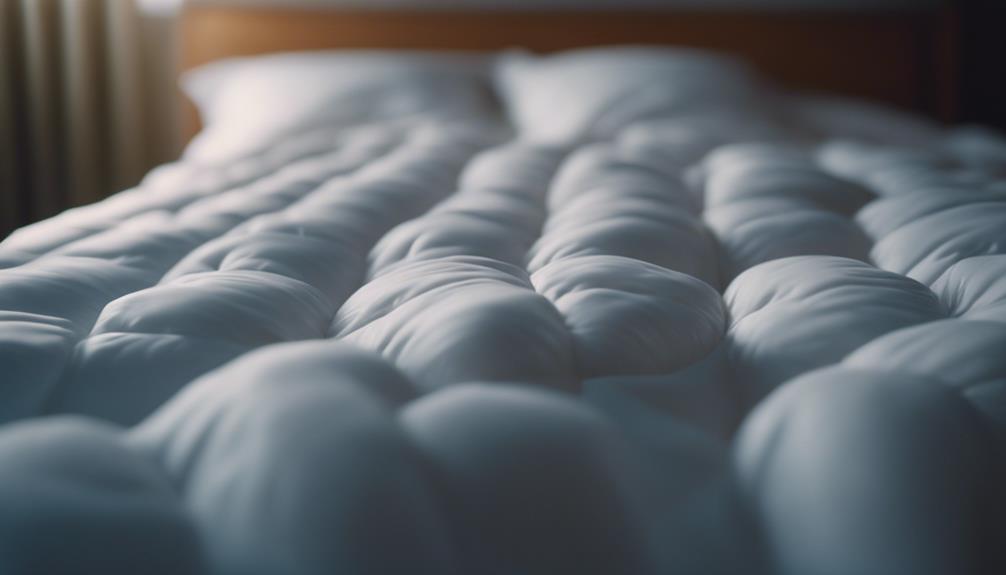
Temperature fluctuations play an essential role in influencing how quickly a down comforter fluffs up. Warmer temperatures can assist the down feathers in expanding and regaining loft more rapidly, expediting the fluffing process. Conversely, colder temperatures may slow down this process, requiring more time for the down comforter to achieve full fluffiness.
Important temperature conditions are vital for enhancing the efficiency of the fluffing up of a down comforter. It's vital to contemplate the ambient temperature in the room where the down comforter is placed to ensure the best results. By selecting a suitable temperature environment, one can positively impact the time it takes for a down comforter to fluff up effectively.
Thus, paying attention to temperature variations is key in facilitating the fluffing process and optimizing the performance of a down comforter.
Understanding Down Filling Behavior

As we explore down filling behavior, it becomes evident that the initial flat appearance of a new down comforter is a common occurrence due to compression during shipping. When a comforter is tightly packed for delivery, the down filling gets squished, reducing its fluffiness.
However, over a few hours on the bed, the down filling will naturally regain its loft and fluffiness as it expands and adjusts to the environment. To expedite this process, daily shaking of the comforter can help redistribute the fill and enhance its loft.
Some new comforters continue to gain loft and fluffiness for up to two weeks after unboxing. If a new down comforter doesn't improve in loftiness over time, it may be a sign to contemplate replacing it to make sure you get the desired level of comfort and warmth.
Understanding how down filling behaves can assist you in maximizing your comforter's fluffiness and longevity.
Patience and Fluffing Expectations

When considering the fluffing process of a down comforter, it's important to manage our expectations.
Understanding the time frame for fluffing, various techniques to enhance loftiness, and the expected results can help us appreciate the progress.
Patience is key as we allow the down comforter to reach its fullest fluffiness potential.
Fluffing Time Frame
Let's discuss the timeframe required for a down comforter to fluff up, emphasizing the need for patience and realistic fluffing expectations. A new down comforter may seem flat initially, but it typically starts regaining its loft after a few hours on the bed. Daily shaking of the comforter can help redistribute the fill and enhance its fluffiness. Some new comforters continue to gain loft for up to two weeks as the down settles and expands. If your comforter doesn't show improved loftiness after this period, it might be time to contemplate a replacement. Proper care, such as shaking and airing out, can maintain and enhance the fluffiness of a down comforter over time.
| Fluffing Time Frame | Expectations |
|---|---|
| Few hours | Initial fluffiness returns |
| Up to two weeks | Continual gain in loft |
| No improvement | Contemplate replacement |
| Proper care | Maintains and enhances fluffiness |
Fluffing Techniques
Exploring effective fluffing techniques for down comforters underscores the importance of patience and managing fluffing expectations.
When using a dryer, it's vital to set it on a low heat setting and add a couple of clean tennis balls to help fluff up the comforter. Remember, the process can take a few cycles to reach the desired level of fluffiness.
Daily shaking and airing out the comforter can also aid in redistributing the down fill and enhancing its loft. It's important to understand that some down comforters may continue to gain loft for up to two weeks as the down settles and fluffs up.
Fluffing Results
As we observe the results of fluffing a down comforter, it becomes evident that patience plays a key role in managing our expectations for achieving peak loftiness. After fluffing, the comforter may still appear flat, but with time and proper care, it will regain its full loft. Regular shaking and airing out the comforter can help maintain its fluffiness. Additionally, using a duvet cover can protect the comforter and assist in preserving its loft over time. For a quick fluff boost, tossing the comforter in the dryer on the air fluff setting can help restore its puffiness. Remember, consistent care and a bit of patience are essential for keeping your down comforter fluffy and cozy.
| Fluffing Results | Tips for Maintaining Fluffiness |
|---|---|
| Initial flatness | Allow time for loft to return |
| Regular shaking | Redistribute fill for loft |
| Air fluff setting | Quick boost for puffiness |
Realistic Fluffing Timeframes

For a new down comforter, it typically takes a few hours on the bed to fluff up and regain its loft. Here are some realistic fluffing timeframes to keep in mind:
- Initial Fluffing: Expect your new down comforter to look flat upon unpacking. Allow it some time on your bed to naturally fluff up and reach its full loftiness potential.
- Daily Shaking: To expedite the fluffing process, shake your comforter daily. This action helps redistribute the down fill evenly, enhancing its loft and overall comfort.
- Continued Fluffing: Some down comforters may continue to gain loft for up to two weeks as the down settles. Be patient and give it time to reach its maximum fluffiness.
- Replacement Consideration: If your new comforter doesn't show significant improvement in loftiness over time, it may be worth considering a replacement. A good down comforter should fluff up and maintain its loft with proper care.
Monitoring Fluffing Progress
When monitoring the fluffing progress of a down comforter, it's important to observe how the fill redistributes over time.
Daily shaking and airing out the comforter can aid in enhancing its loftiness.
Fluffing Timeframes
Monitoring the progress of fluffing a down comforter involves observing how it regains loftiness over time. Here are some key points to keep in mind when monitoring the fluffing timeframes:
- A new down comforter may take a few hours to fully fluff up on the bed.
- Daily shaking and airing out can help the down comforter regain its loftiness.
- Some down comforters continue to gain loft for up to two weeks after unboxing.
- If a new comforter doesn't fluff up within the expected timeframe, contemplate replacing it.
Proper care and maintenance play an important role in expediting the fluffing process of a down comforter.
Fluffing Techniques
To effectively gauge the progress of fluffing a down comforter, a consistent routine of shaking and airing out is essential. Daily shaking helps redistribute the fill inside, enhancing the comforter's loft and fluffiness.
By gently shaking the comforter and allowing it to breathe, you can monitor its progress in regaining its fullness. Remember, some new comforters may continue to gain loft for up to two weeks after unpacking.
If your comforter doesn't regain its fluffiness over time, it might be time to contemplate replacing it. Proper care, including regular shaking and airing out, is key to maintaining and improving the fluffiness of your down comforter.
Frequently Asked Questions
Why Isn't My Down Comforter Fluffy?
If your down comforter isn't fluffy, it may need time to expand after being compressed. Regular shaking and gentle fluffing can help speed up the process. Factors like the down filling type and fabric quality can influence how quickly it fluffs up.
If it stays flat for too long, it might be due to low-quality materials or construction. Give it some time and care, and it should fluff up nicely.
How to Make Your Down Comforter Fluffy Again?
To make your down comforter fluffy again, try daily shaking and airing it out to redistribute the fill and enhance loft. This process can take a few hours to a couple of weeks, depending on the comforter.
If the loft doesn't return, it may be time to replace it. Remember, gentle use, proper washing, and storage are key to maintaining the fluffiness of your down comforter.
Can Down Comforter Go in the Dryer?
Yes, down comforters can go in the dryer on a low heat setting. Using dryer balls helps distribute the down filling evenly. Avoid high heat to prevent damage.
Regularly fluff and dry the comforter to maintain loftiness. Follow the manufacturer's care instructions for safe drying.
It's important to take proper care of your comforter for long-lasting fluffiness.
What to Do When You First Get a Down Comforter?
When you first get a down comforter, it may seem flat initially. To help it fluff up, shake and fluff it daily. This will redistribute the fill and enhance its loftiness.
Some new comforters can take up to two weeks to fully fluff up as the down settles. If your comforter doesn't improve even with care and time, consider replacing it for best comfort and warmth.
– Does the fluffiness of a down comforter affect its safety for toddlers?
When it comes to down comforters for toddlers safety, the level of fluffiness can impact their safety. A down comforter that is too fluffy can potentially pose a suffocation risk for young children. It’s crucial to carefully consider the fluffiness and overall design of the comforter to ensure a safe sleeping environment.
Conclusion
To sum up, the time it takes for a down comforter to fluff up can vary depending on factors like filling type and drying method.
While some may expect instant results, it's important to be patient and understand that fluffing takes time.
By monitoring progress and adjusting methods as needed, you can achieve the desired fluffiness in a realistic timeframe.
Remember, good things come to those who wait and take the time to care for their bedding properly.
